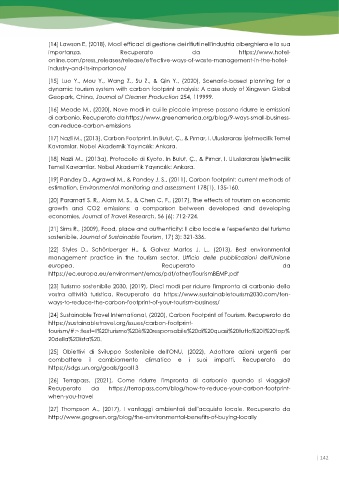Page 142 - Toucan_Modules_IT
P. 142
[14] Lawson E. (2018), Modi efficaci di gestione dei rifiuti nell'industria alberghiera e la sua
importanza. Recuperato da https://www.hotel-
online.com/press_releases/release/effective-ways-of-waste-management-in-the-hotel-
industry-and-its-importance/
[15] Luo Y., Mou Y., Wang Z., Su Z., & Qin Y., (2020), Scenario-based planning for a
dynamic tourism system with carbon footprint analysis: A case study of Xingwen Global
Geopark, China, Journal of Cleaner Production 254, 119999.
[16] Meade M., (2020), Nove modi in cui le piccole imprese possono ridurre le emissioni
di carbonio. Recuperato da https://www.greenamerica.org/blog/9-ways-small-business-
can-reduce-carbon-emissions
[17] Nazli M., (2013), Carbon Footprint. In Bulut, Ç., & Pırnar, I. Uluslararası İşletmecilik Temel
Kavramlar. Nobel Akademik Yayıncılık: Ankara.
[18] Nazli M., (2013a), Protocollo di Kyoto. In Bulut, Ç., & Pırnar, I. Uluslararası İşletmecilik
Temel Kavramlar. Nobel Akademik Yayıncılık: Ankara.
[19] Pandey D., Agrawal M., & Pandey J. S., (2011), Carbon footprint: current methods of
estimation, Environmental monitoring and assessment 178(1). 135-160.
[20] Paramati S. R., Alam M. S., & Chen C. F., (2017), The effects of tourism on economic
growth and CO2 emissions: a comparison between developed and developing
economies, Journal of Travel Research, 56 (6): 712-724.
[21] Sims R., (2009), Food, place and authenticity: Il cibo locale e l'esperienza del turismo
sostenibile, Journal of Sustainable Tourism, 17( 3): 321-336.
[22] Styles D., Schönberger H., & Galvez Martos J. L., (2013), Best environmental
management practice in the tourism sector. Ufficio delle pubblicazioni dell'Unione
europea. Recuperato da
https://ec.europa.eu/environment/emas/pdf/other/TourismBEMP.pdf
[23] Turismo sostenibile 2030, (2019), Dieci modi per ridurre l'impronta di carbonio della
vostra attività turistica. Recuperato da https://www.sustainabletourism2030.com/ten-
ways-to-reduce-the-carbon-footprint-of-your-tourism-business/
[24] Sustainable Travel International, (2020), Carbon Footprint of Tourism. Recuperato da
https://sustainabletravel.org/issues/carbon-footprint-
tourism/#:~:text=Il%20turismo%20è%20responsabile%20di%20quasi%20tutto%20il%20top%
20della%20lista%20.
[25] Obiettivi di Sviluppo Sostenibile dell'ONU, (2022), Adottare azioni urgenti per
combattere il cambiamento climatico e i suoi impatti. Recuperato da
https://sdgs.un.org/goals/goal13
[26] Terrapass, (2021), Come ridurre l'impronta di carbonio quando si viaggia?
Recuperato da https://terrapass.com/blog/how-to-reduce-your-carbon-footprint-
when-you-travel
[27] Thompson A., (2017), I vantaggi ambientali dell'acquisto locale. Recuperato da
http://www.gogreen.org/blog/the-environmental-benefits-of-buying-locally
| 142

